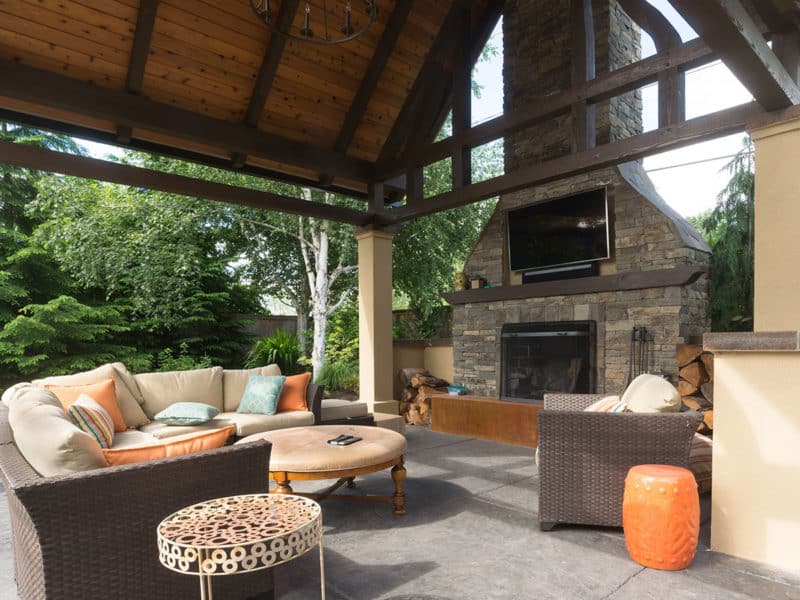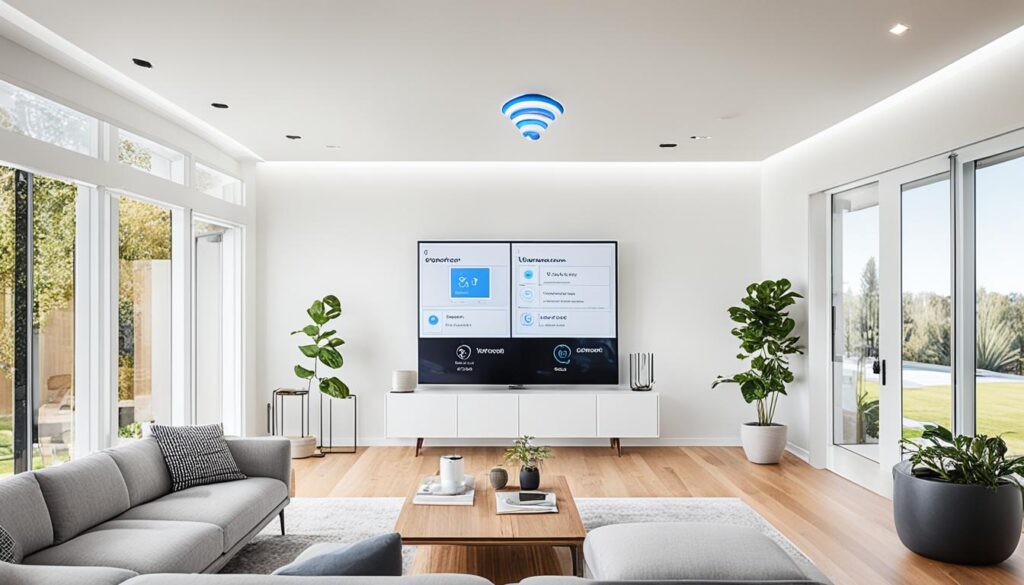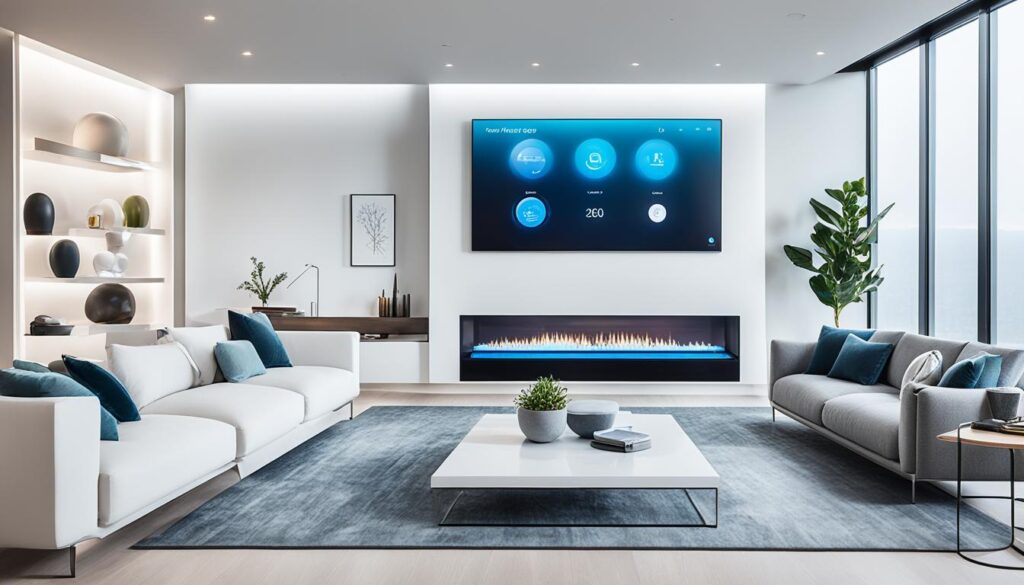We’re thrilled to introduce you to the dynamic world of Smart Home Automation Systems. Envision your home as a seamless network where control is at your fingertips or through your voice. Adjust temperatures, lock doors, and activate devices with unparalleled ease. Beyond outdated thermostats and remote TVs, we now embrace an era where smart systems integrate devices for comprehensive home management. This innovation offers convenience, energy efficiency, enhanced security, and a personalized living space tailored to your lifestyle.

Key Takeaways
- Smart Home Automation Systems revolutionize the concept of homes, transforming them into central, comprehensive control stations.
- The integration of a wide array of connected devices bolsters the effectiveness of automated home control.
- From heating to security, smart home features cover a wide spectrum of operations, enhancing overall convenience and efficiency.
- Through these systems, it is possible to create a personal environment that adapts to the residents’ lifestyles.
- An investment in smart home automation can result in considerable energy savings and increased security.
Unlocking the Potential of Smart Home Automation Systems
As we explore the wonders of home automation technology, it is crucial to comprehend the countless benefits of using these significant innovations. Smart home automation systems are thriving, promoting not only convenience and efficiency but also providing comprehensive solutions to make our daily lives easier. With a wide range of voice-controlled home devices, smart thermostat installation, and home security automation, homeowners are experiencing a lifestyle transformation like never before.
What is Home Automation? Understanding the Basics
Home automation embodies the inception of a convenient and efficient lifestyle. By managing essential household devices remotely or through programmable routines, we are able to engage with the digital world in a physical sense. The use of smart lighting systems and voice-controlled home devices paves the way for this surreal amalgamation of physical and digital living spaces.
The Evolution of Smart Home Technology: From Luxury to Necessity
Once considered a luxury, smart home automation technology has now become a household necessity. This shift is driven by the desire for heightened efficiency, increased security, and luxury within the home. The projected expansion of the smart home market, with prospects of hitting USD 13 trillion by 2030, stands as a testament to this evolution.

Integrated Home Ecosystems: How Devices Communicate for Seamless Control
The core of home automation lies in the integration of various smart home devices. This amalgamation provides a seamless and efficient system, ensuring all devices harmoniously function with one another. Take smart light bulbs, for instance. They can be programmed to dim or brighten at set times or controlled through voice commands. The smart thermostat can adjust room temperature based on daily routines or even when everyone leaves the house.
Smart Home Features: Enhancing Daily Living
Smart home features are not merely about remote monitoring or entertainment; they significantly improve our everyday lives. With fitness trackers and air purifiers, we embark on a healthier lifestyle. As residents of a smart home, we wake up to the gradual brightening of lights and the aroma of freshly brewed coffee. It’s like living in a home that is second-guessing our every need.
| Smart Home Devices | Functions |
|---|---|
| Smart Lighting Systems | Programmable lights to suit daily routines |
| Voice-Controlled Home Devices | Execute commands through voice control |
| Smart Thermostat Installation | Adjust room temperature based on routines and absence |
| Home Security Automation | Enhances home security through integrated devices |
The Heart of the Automated Home: Devices and Technologies
Exploring the heartbeat of smart home automation systems, you discover a fascinating world of devices and technologies. The linchpins of these systems are the smart devices that shape the modern home, delivering unprecedented convenience, efficiency, and security.

Smart thermostats are changing the way we regulate temperature, offering immediate control and learning our preferences. They’re part of a broader home automation system that can create a personalized environment from the moment you wake up, including adjustments in temperature, lighting, and even playing your favorite morning news. Home security has also been transformed with devices like video doorbells, motion-activated cameras, and smart locks, enhancing safety with the ability to monitor your home in real time. Smart home automation extends to entertainment, allowing for customized experiences in home theaters or during family karaoke sessions, ensuring comfort, convenience, and peace of mind in every aspect of home life.
| Smart Home Technologies | Roles |
|---|---|
| Microprocessors and Sensors | Collect and process information, making intelligent automated decisions |
| Networking Technologies | Facilitate communication between different smart devices |
| User Interfaces | Allow interaction between homeowners and the automation system |
Developers and tech enthusiasts continually monitor trends and technological advancements in home automation, acknowledging the critical roles of microprocessors, sensors, networking technologies, and user interfaces. These components work together to enable the smart devices to communicate and function as a unified, intelligent system, paving the way for greater innovations in Smart Home Automation Systems.
Conclusion
We stand on the cusp of a new age, one in which Smart Home Automation Systems and connected devices revolutionize our daily lives. Far from being a glimpse into a distant future, the cutting-edge of home automation is readily accessible here and now, serving to both augment and streamline our day-to-day tasks.
The Future is Now: Embracing Smart Home Automation
As our homes grow increasingly intelligent, augmented reality applications for health and an array of interconnected devices have started to render the monotonous tasks of yesteryear obsolete. Such an advancement has not only improved our ease of living but has begun reshaping the very fabric of households across America.
Transforming Households Across America: The Impact of Automation
Home automation has transformed American homes into spaces that are efficient, responsive, secure, and, most importantly, adapted to our unique lifestyles. As we step into a home environment seamlessly integrating tailored smart home features controlled by automated home control systems, we can’t help but marvel at the profound impact automation has had on our domestic lives.
Making the Leap to a Smarter Home: Next Steps for Homeowners
For those poised to make the leap into the future of home automation, the journey starts by identifying their unique needs and selecting a compatible hub or ecosystem. Whether it’s Apple HomeKit, Google Home, or Amazon Alexa, homeowners are granted a selection of systems, each offering its unique advantages. Looking forward, we expect AI and machine learning to impart further enhancements—developing self-regulating and predictively responsive homes that will eventually become the new standard for American homeowners.
FAQs
What does smart home automation involve?
Smart home automation involves the use of interconnected devices that can be remotely controlled through a central hub or a smartphone. It encompasses features such as automated home control, smart lighting systems, voice-controlled home devices, and home security automation for enhanced convenience, energy savings, and personalized living.
How does home automation technology work?
Home automation technology integrates smart devices into a single ecosystem. This allows for seamless and centralized control, with devices communicating with each other. Examples include smart thermostat installations that learn and adjust to user habits or smart lighting systems that can be programmed to operate at specific times.
Could you elaborate on the evolution of smart home technology?
Smart home technology has evolved from basic programmable devices, such as thermostats and remote-controlled TVs, to complex systems that interlink a wide range of devices. Today, home automation is seen as a practical necessity rather than a luxury, with the market projected to hit USD 13 trillion by 2030.
What kind of smart home features enhance daily living?
Smart home features that enhance daily living include remote monitoring of the home environment, programmable household routines, energy management through intelligent adjustments, and enhanced security through motion-activated cameras and video doorbells. Entertainment is also smarter with home theaters and sound systems that respond to simple commands.
How can I make the transition to a smarter home?
To transition to a smarter home, you may start by identifying your goals and choosing a compatible home automation system like Apple HomeKit, Google Home, or Amazon Alexa. Keep in mind that embracing home automation is not merely about adopting high-tech gadgets; it’s about creating a home environment that’s more efficient, responsive, and secure.
Source Links
- https://www.linkedin.com/pulse/unlocking-power-home-automation-comprehensive-guide-jayprakash-shet?trk=article-ssr-frontend-pulse_more-articles_related-content-card
- https://www.hindawi.com/journals/jece/2023/7616683/
- https://thtva.com/embracing-the-future-a-comprehensive-guide-to-home-automation/

From curious child to the President of WyreDreams, my journey started with a fascination for the wires behind my dad’s boombox. Today, I lead a team dedicated to transforming standard setups into exceptional audiovisual and smart home experiences.

